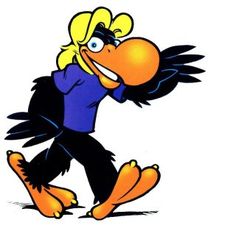First, the Toucan, though. Rick Geary moved to San Diego in 1975. He began working on comics and was a regular contributor to National Lampoon, and later had work published in Heavy Metal. Not surprisingly, he became somewhat involved with Comic-Con and, in 1984, came up with a toucan character to be used on letterheads and other stationery. Geary has noted, “At the time, I was big into animals in human clothing, so I drew this generic big-beaked bird, never intending it to be a toucan. Also, I understood at the time that this was just to be used for a few things. I had no notion of it becoming Comic-Con's permanent logo.” But it got to be used more and more, the illustration getting streamlined in the process and, though, in 1995 CCI adopted the "eye" logo they still use today, the toucan (whose name, as far as I can tell, is "Toucan") has continued to show up in various ways.
Although, a radio station in Cleveland using the 100.7 MHz frequency dates back to 1946, the station changed identities several times over the years before landing on a progressive rock format branded as WMMS in 1968. At the time, their logo prominently featured mushrooms and a smoking fairy-like creature. In 1974, listener David Helton sent in a complaint letter in the form of a cartoon. It featured a buzzard perched atop a mushroom, suggesting that the station was dying as evidenced by some format changes he thought they'd recently introduced. (In fact, the change he was complaining about -- that the National Lampoon Radio Hour was cut from an hour to a half-hour -- was a joke by the show itself. "Ha ha! We have a show with 'hour' in the title but it's only 30 minutes long!") In any event, the new program manager John Gorman liked the buzzard character; he thought it tied in with the general sentiment at the time that Cleveland itself was a dying city. They hired Helton to work the buzzard up into the advertising, and he debuted as the station's official mascot in April 1974 in an alternative weekly paper called Zeppelin. The character (who's only ever been called "The Buzzard") has likewise been streamlined over the years, and become more mainstream like the station itself.
While Geary, by contrast, cites the likes of Winsor McCay, Franklin Booth, and W. Heath Robinson as influences, that he was living just up the coast a bit from Crumb during the height of the underground comix movement, it's hard to believe there wasn't some influence on his work as well. While Toucan and The Buzzard may not exactly have been brothers, I think there's actually a pretty strong argument that they're cousins.










0 comments:
Post a Comment